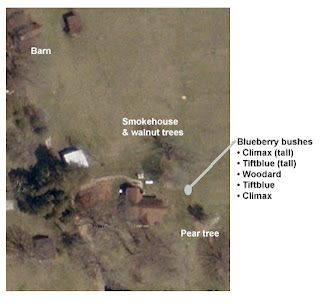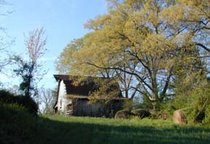For us university folk, the beginning of spring break is one of the most wonderful times of the year. Students' yearnings for a break doesn't begin to match that of the faculty and staff, and the beginning of spring break is better than Christmas morning for a four-year-old.
Today was that day.
I fled campus as quickly as I could (shortly after noon), determined to enjoy the clear day, soft breezes and 60 degree temps. I was not disappointed. A few days ago, I had spotted some blueberry bushes on sale at the local Home Depot. They were about three times as tall as the once that I had set out in January, so I picked up a couple of them on the way down to the farm.
A few days ago, I had spotted some blueberry bushes on sale at the local Home Depot. They were about three times as tall as the once that I had set out in January, so I picked up a couple of them on the way down to the farm.
The store had two varieties -- Tiftblue (or Tifblue) and Climax -- and I got one of each. I had set out a Tiftblue, Climax and Woodward in January, so I was glad to get a couple of taller versions of the same variety.
I am putting the bushes at the western end of Paw's garden. Paw (otherwise known by his Blount County nickname "Frog") was my father-in-law and had a garden that stretched from the eastern end of his property to nearly the side of his house. The land has not been tilled in about 10 years, so we are going to start our planting on a small portion of this land. Blueberries are the first thing we have put in, but there will be more.
I have lined these bushes up in a north-south line with the two latest (and tallest) bushes on the northern side. The bushes are about eight feet apart, giving them room (I hope) to flourish.
Paw (Ray McMillan, who died after about seven years in a nursing home last November) never fooled with fruit very much. He was a vegetable and tomato man. And he would plant anything his daughters Sally and Jane asked for. And it was inevitably good. So maybe a little of Paw's magic is still in the ground, waiting for someone to turn it over. If that's all it takes, I am willing to do my part.
Building beehives
The last nails went into the frames and boxes of the six hive boxes that I have been building to start my beekeeping venture in April. The hives are not yet complete. They still need bottom boards, inner covers and tops -- in addition to some kind of hive stands to get them off the ground.
I will be spending a good part of spring break working on all that.
I am planning on locating the hives a few feet east of the pear tree (see picture above) so they will get the afternoon shade from the pear tree and other objects to the west. But more on that later.
The hive-building project has been a good one. As I noted previously, building a hive takes a bit of carpentry work, but a good hive box and frame -- one that is closely milled -- will fit together well enough to make you feel like an expert.
I had completed many of the hive boxes and frames by the time the Blount County Beekeepers Association's woodworking workshop rolled around last Saturday at the Masonic Hall in Alcoa. I was determined to attend but did so with some trepidation, wondering what I would do if I discovered that all I had done to that point was wrong.
Fortunately, it wasn't.
The workshop was conducted by Dennis Barry (on the left in the top picture), Terry Best and Bob Landers, who have many years of beekeeping under their belts. As with everything else having to do with beekeeping, there are many ways to build a hive and many opinions about it. But taken together, these guys gave us a lot of good advice not just about building hives but beekeeping itself.
I figured that would be the case, so that's why I went.
Terry Best, who keeps 20 to 30 hives each year, told us that his general philosophy was to leave the bees alone as much as possible and let them do their work. He said he tried to look into his hives only about four times a year. I like that approach and am going to try to emulate it.
One of the most valuable hands-on things I learned on Saturday was how to lay in a foundation into a frame. A foundation is a wax sheet reinforced by wires that fits into the center of a frame. The bees use this foundation to begin "drawing the comb," or building the part of the hive in which the queen lays eggs and they store honey. Laying the foundation sheets is not difficult but a bit delicate, and it was good to have expert hands to direct us.
Many thanks, guys.
Dolly
It has been two weeks today since anyone saw Dolly, the cat. Our neighbor has spotted coyotes this winter (we saw one or two last summer) and told us that one had killed one of his small dogs a few weeks earlier. It pains me to think that Dolly may have met her end that way, but that's likely what happened.
Dolly is the second cat we have lost in the last year. Squeaks, our beautiful, black long-haired cat, had to be put to sleep last Aug. 1. Squeaks was with us for 10 years in Tuscaloosa, Emory and Maryville, and for reasons known only to her, she considered me her Number One Compadre. Squeaks could be irritating at times and was always high maintenance, but she proved herself to be a true friend a few times when I just needed her to be there. I still miss her.
So the cats come and go in our lives. They give us a lot of joy when they are here and leave a real empty spot when they depart.
Friday, March 9, 2007
From building hives to blueberry bushes
Labels:
beehives,
Beekeepers Association,
bees,
blueberries,
Dolly,
Squeaks
Subscribe to:
Post Comments (Atom)





No comments:
Post a Comment